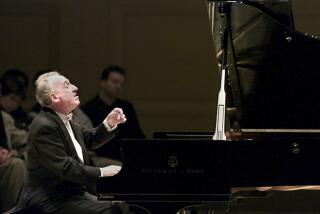Indeed, Mr. Stradivari didn’t fiddle around in his shop
- Share via
ANTONIO Stradivari labored for 71 years in his Cremona, Italy, workshop, creating more than 1,000 string instruments, some 600 of which survive and set the gold standard for the field. Indeed, a violin he made in 1707 sold this month for more than $3.5 million -- far exceeding the previous price for any instrument.
Yet although he was assisted by two sons for upward of 50 years, neither inherited his genius. His secrets died with him, and despite more than 250 years of investigations, probes, measurements and assorted theories, they remain buried.
Or maybe not.
Toby Faber, grandson of the founder of the publishing house Faber and Faber, tells that story in “Stradivari’s Genius,” now out in paperback from Random House. The book focuses on five Strad violins, one Strad cello and their great and not-so-great players and owners.
“Talking to players and dealers, one thing that came up was what a funny world the whole world of violin dealing is,” Faber said during a recent stop in Pasadena on a book tour.
“The crucial thing about these instruments -- when it comes down to anyone spending millions of dollars -- is a violin has to be authentic. But the dealers are the only ones who really have the pictorial memory that comes from handling thousands and thousands of violins, so they can identify what makes an instrument a real Stradivarius.”
That fact might, of course, be an invitation to false dealing. But Faber said that “all the dealers I dealt with were very charming and came across in most cases as people of integrity too.”
Instead, “what they tended to do is tell stories of how their predecessors’ guarantees weren’t necessarily worth the paper they were written on.”
As for Stradivari’s “secrets,” Faber examines the usual theories: Stradivari used a secret varnish. He put a special layer of volcanic ash between the wood and the varnish. He soaked his wood in salt solutions. His wood was denser because it was cut after Europe’s mini-Ice Age in the 15th and 16th centuries.
“I put all those theories out as a sort of smorgasbord,” Faber said. “You can always pick and choose as to what would make a difference. But what I come back to saying is, actually, you don’t need to believe in any of them.”
Amid “all these searches for some sort of silver-bullet solution to what it is that makes a Stradivarius so good,” he said, “a lot of people for a long time -- up until about 20 years ago -- simply ignored making violins as well as they could.”
That may be the secret after all.
“I’m sure that if Stradivari were alive today, he would not simply be trying to do what he did 200 years ago,” Faber said. “He would be trying to make the best violins he could. I do think that the violins being made now will in 50 or 100 years sound as good or even better, perhaps even supersede Stradivariuses.”
Even if they do, though, there’s something newer instruments can never have -- the fabulous histories that Faber traces in his book.
“The idea that the violin Yehudi Menuhin played in the great performances we still have recordings of today is also the violin that was used in the first performances of Beethoven’s late quartets -- that sort of link is wonderful,” he said.
More to Read
The biggest entertainment stories
Get our big stories about Hollywood, film, television, music, arts, culture and more right in your inbox as soon as they publish.
You may occasionally receive promotional content from the Los Angeles Times.










